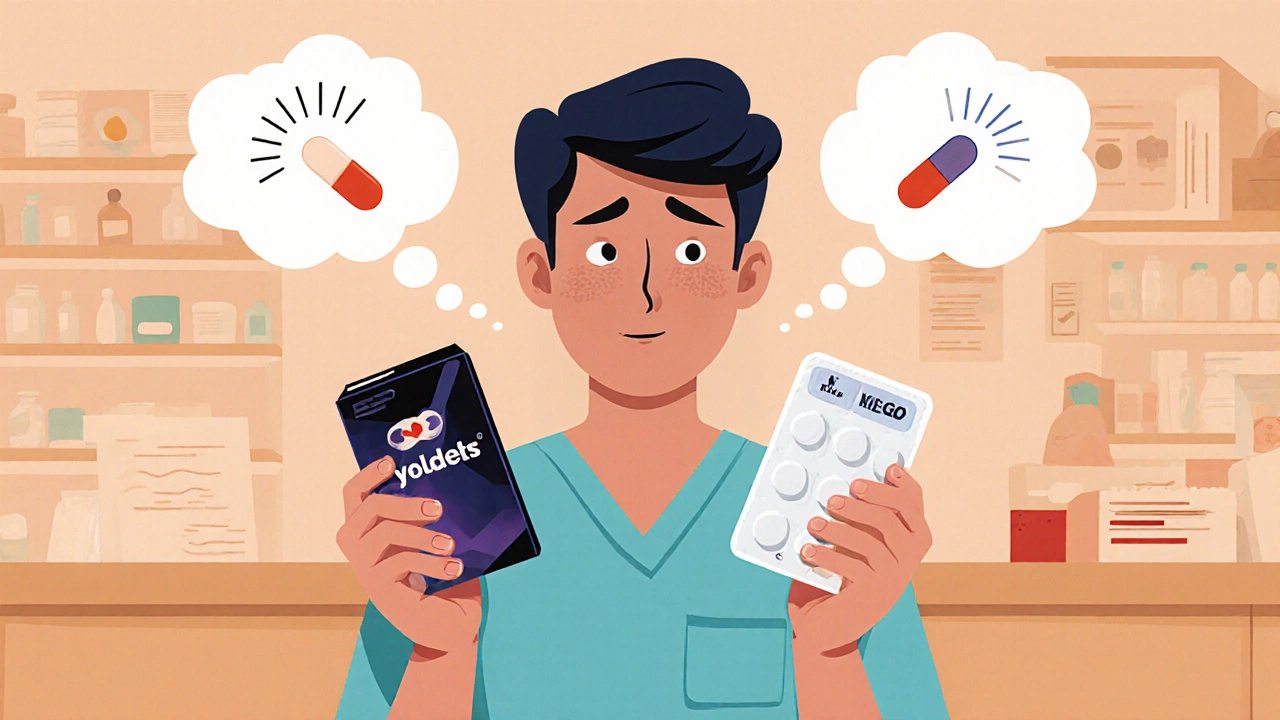When a patient switches from a brand-name drug to a generic version, they don’t just change the pill’s color or label-they change their expectations. And those expectations can literally change how they feel. A 2025 study showed that healthy people given a fake nasal spray labeled as a generic reported more side effects than those given the exact same spray labeled as a brand-name product. No active ingredient was involved. Just the label. That’s the nocebo effect in action: negative beliefs turning into real physical symptoms.
What Exactly Is the Nocebo Effect?
The nocebo effect isn’t just being pessimistic. It’s a measurable, repeatable phenomenon where expecting harm leads to actual harm. The word comes from Latin: nocebo means "I shall harm." In medicine, it’s the flip side of the placebo effect. Where placebo turns hope into healing, nocebo turns fear into suffering. Research from Harvard and Brigham and Women’s Hospital found that patients who believed they were taking a generic version of a medication reported more side effects-even when the drug was chemically identical to the brand. In one study, 196 participants were given a sham treatment. Those told it was a generic version reported significantly more nausea, dizziness, and fatigue than those told it was a branded version. The drug had no active ingredient. The symptoms were real. The cause? Belief. This isn’t rare. In clinical trials, about 1 in 5 people taking a sugar pill report side effects. Nearly 1 in 10 drop out because of them. That’s not because the pill is dangerous. It’s because they were told to expect something bad.Why Do People Think Generics Are Worse?
It’s not irrational. It’s deeply human. We judge medicines the same way we judge everything else: by appearance, price, and reputation. A 2024 study tested a fake anti-itch cream. One group got it in a sleek blue box with a fancy name: "Solestan® Creme." The other got the same cream in a plain orange box labeled "Imotadil-LeniPharma Creme." The cream had no active ingredient. But the people who thought they were using the expensive version reported less pain. The people who thought they were using the generic? They felt more pain. Packaging matters. Price matters. Brand names matter. When a patient sees a generic pill that looks different-smaller, cheaper-looking, with a complicated name like "Sertraline Hydrochloride 50 mg" instead of "Zoloft"-their brain jumps to conclusions. "This must be weaker. This must be worse. This must cause side effects." The problem gets worse when pharmacies switch brands without warning. In New Zealand, when venlafaxine switched from brand to generic, adverse effect reports didn’t spike until the media started covering it. Once patients heard "your drug changed," their brains started scanning for symptoms they’d never noticed before.Generics Are Just as Safe-Here’s the Proof
The FDA and the European Medicines Agency don’t approve generics lightly. To be sold, a generic must prove it delivers the same amount of active ingredient into the bloodstream at the same rate as the brand. That’s called bioequivalence. The acceptable range? 80% to 125% of the brand’s performance. That’s not a guess. It’s science. In Australia, where generics make up over 85% of prescriptions, the Therapeutic Goods Administration (TGA) requires every generic to undergo the same strict testing as the brand. The same manufacturers often produce both. Many brand-name drugs are made in the same factory as their generic versions. The only difference? The label. A 2023 study in PLOS Medicine looked at authorized generics-drugs made by the brand company itself, sold under a generic label. Even then, patients reported more side effects on the generic version. Why? Because they thought they were getting something inferior. The data is clear: if you’re having side effects after switching to a generic, it’s not because the drug is different. It’s because your brain thinks it is.
How Doctors and Pharmacists Can Help
The most powerful tool against the nocebo effect isn’t a new drug. It’s a new conversation. Instead of saying, "This generic might cause headaches, dizziness, or nausea," try: "Most people take this medication without any issues. The active ingredient is exactly the same as what you were on before. Many patients even feel better because they’re saving money." Don’t list every possible side effect. That’s not informed consent-it’s suggestion therapy. Focus on what matters: safety, effectiveness, and reassurance. Kaiser Permanente uses a simple script when switching patients: "This medication has the same active ingredient as your old one. Studies show patients do just as well on it. You’re not losing anything-except the extra cost." That script reduced nocebo-related dropouts by 30% in their pilot program. Pharmacists can help too. When handing over a new prescription, say: "This is the same medicine, just without the brand name. You’ll get the same results, and you’ll save about $200 a year." Patients don’t need jargon. They need clarity and confidence.What Patients Can Do
If you’ve switched to a generic and started feeling worse, pause. Ask yourself: Did this symptom exist before? Or did it start after I heard this was a "generic"? Keep a simple symptom journal. Note the date, time, and intensity of any new feeling. Then, compare it to your baseline. Did your sleep change? Your mood? Your energy? Or are you just noticing normal sensations you used to ignore? Talk to your doctor. Say: "I’m worried the generic isn’t working like the brand did. Can we check if this is a perception issue?" You’re not crazy. You’re not weak. Your brain is doing exactly what it’s designed to do-protect you from harm. But sometimes, it protects you from something that isn’t there.



so like if i tell my friend his generic adderall is just as good as the brand he’ll stop feeling tired? lol